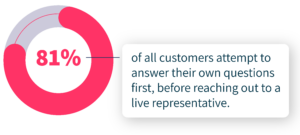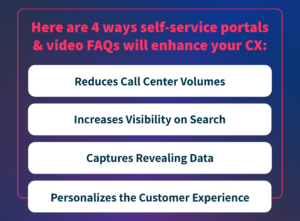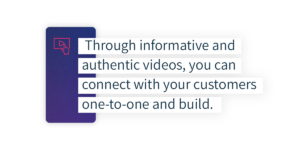Self-service portals are changing the customer experience (CX). Brands can serve their customers faster – while saving costs – through digital self-service options on their websites or app.
Think of the last time you experienced an internet issue. Did you visit your service providers’ website first to find the answer to your problem? Or did you pick up the phone and call the call center only to be on hold?
Most people opt for the first option, customer self-service portals, and brands are starting to notice.
What is Customer Self-Service?
Customer self-service is any online action a customer takes to find information about a brand or resolve an issue without assistance from the company.
Self-service portals are online hubs where customers can go to find information and resources about the product or service. Portals can be directed at both customers and employees.
The most common types of customer self-service include a FAQ page, articles and how-to guides.
Why Are Brands Turning to Self-Service Portals?
Customers are savvy, resourceful and time-starved. The days of waiting on the phone for hours to speak to a customer service rep are fading.
According to Harvard Business Review, across industries, 81% of all customers attempt to answer their own questions first, before reaching out to a live representative. Additionally, a Zendesk Survey revealed that 67% of customers prefer self-service options over speaking to a company representative.

But, posting paragraphs of text-based information on your website isn’t enough. Customers are looking for quick answers to their questions. That’s why brands need engaging self-service content that grabs attention and answers questions directly.
Enter video FAQs.
Video offers a unique opportunity to enhance the self-service experience for users.
On one hand, videos are engaging. Users with short attention spans will find the answers they’re looking for quickly through video. On the other hand, videos can be highly personalized to meet the needs of customers.
Video FAQs are excellent tools to help your customers find what they are looking for and learn more about your brand, product or service with little effort.
4 Ways Self-Service Portals & Video FAQs Will Enhance Your CX

1. Reduces Call Center Volume
Investing in a well-crafted self-service portal is the first step to improving CX. Including video FAQ is the second. Compelling and digestible content such as video answers makes it easy for customers to resolve their questions and in turn, reduces call center volume.
For those customers who do call into the call center, their wait will likely be shorter, reducing frustration and improving their experience. Not to mention, fewer calls to your call center means reduced costs for your business. Self-service portals make it possible to serve more customers at a lower cost.
2. Increases Visibility in Search
The more quality content you post on your website, the more visibility you’ll have on search engine result pages (SERP). Include video as your content, and your SEO will skyrocket. Video SEO is one of the best strategies to be found by your audience quicker and easier.
Search engines prioritize video by ranking it separately from text-based results. This gives video content more visibility and ultimately drives more traffic to your website. For customers searching online for answers, having easily discoverable information about your brand will enhance their experience that much more.
3. Captures Revealing Data
The content embedded on your website captures data that you can use to better your CX. Video content is an excellent tool to track the success of your self-service content, like FAQs. You can view which video FAQ is being viewed the most by your customers and which parts customers are viewing more than once. This type of data will showcase areas of your processes to optimize or tweak to meet the needs of your customers.
Additionally, website analytics data will improve with self-service portals. Your customers will spend more time on your website watching videos and reading through articles, leading to increased pages per session and decreased bounced rates.
4. Personalizes the Customer Experience
Once you know what your customers are looking for, you’ve unlocked the key to what you need to create. Use video as an easy tool to personalize your content with video. Through informative and authentic videos, you can connect with your customers one-to-one and build relationships.

Users are searching for anything and everything online. By posting personalized and specific content, you’ll increase connection with your viewers and in turn strengthen brand loyalty.
Enterprise brands like Telus leverage StoryTap’s video FAQ to create highly customized video answers that meet the direct needs of their customers.
Strengthen CX with StoryTap
StoryTap gives you the tools you need to improve CX with self-service portals and video FAQs. Our patented video engagement solution makes it easy to create video answers to the questions your customers are searching for.
Our team will implement SEO strategies to boost the visibility of your brand online, from indexing your content and embedding it on your website. We’ll also streamline your video process to make creating and sharing your videos seamless.
Invite your customers and employees to ask questions or offer genuine answers. Our personalized storylines and customer-friendly software will make anyone feel comfortable recording a video.
Book a demo with our team today and learn how we can help simplify your process and strengthen CX.


